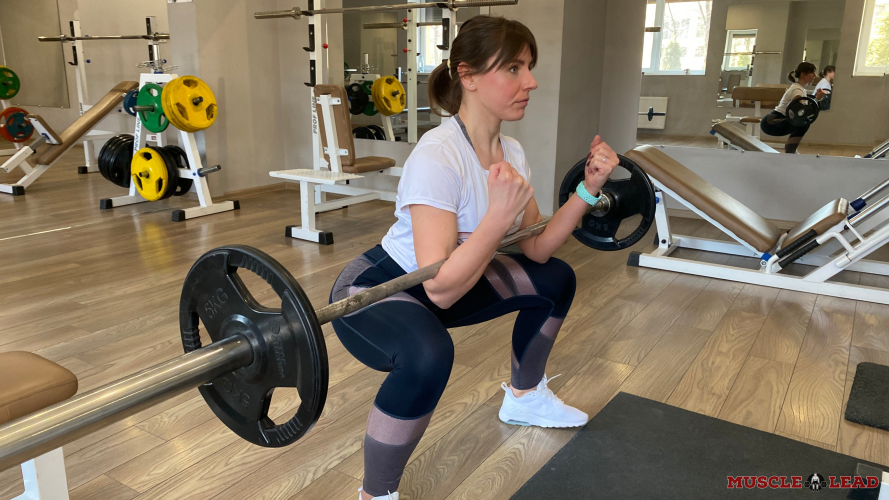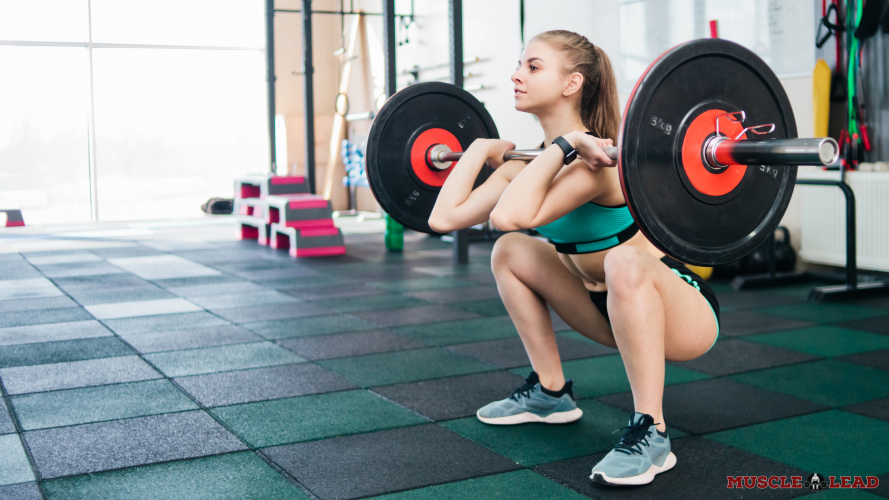You may have noticed, here at MuscleLead we love squats. All types of squats!
Squats are a fundamental part of any strength-building routine as well as foundational movement in many sports.
The squat is one of the most basic of human actions, and proper squat kinematics play a significant role in the longevity of healthy activity. It is proven that squatting is one of the best exercises to continue in later life.
Zercher Squat vs Front Squat: 3 Main Differences
“Group-based body-weight squat exercise performed twice weekly for 12 weeks does improve muscle strength and muscle thickness in physically frail older adults.”
Fujita et al 2016 [1]
Quite simply, squats are good for us… Very good for us…
Not only do squats encourage efficient movement patterns and mobility as we get older, but there is also evidence to suggest that the strength and mobility developed through squats can protect athletes from injury.
Case et al [2] found that both male and female athletes who had displayed a stronger 1 rep max back squat during pre-season, had a lower likelihood of injury when compared to weaker athletes.
“Individual and mean 1RM relative back squat strength values. Uninjured (UINJ) athletes had significantly higher relative back squat strength than injured (INJ) in both men (p 5 0.02) and women (p 5 0.04).”

Following on from our Ultimate Guide To The Zercher Squat, where we learned the obvious benefits of squatting with the bar in front of the body, this article goes one step further and discusses the differences between the Front Squat and the Zercher Squat.
Although the Zercher squat and front squat are similar exercises in terms of the muscle groups they target, there are some notable differences that we need to consider, if we are to optimize our training.
1. The Bar Position
Zercher Squat
The Zercher squat requires the lifter to cradle the barbell in the crooks of their elbows. Holding an isometric, half bicep curl secures the bar close to the sternum. It is much more demanding on the arms to hold the barbell in place throughout the movement, compared with the front squat.
Front Squat
The front squat requires the lifter to place the bar on the front of the shoulders while supporting the bar with the hands in a clean width grip. This is often called the “front rack position”. This position usually has the bar make contact with the collarbones.
The goal is to maintain a full grip on the barbell, rather than allowing the fingers and wrists to bend backward. This is a demanding position and if it is not possible to perform the rack grip with proper form, the “cross grip” is a suitable alternative, whereby the lifter crosses the forearms in front of the chest and applies hand pressure to the bar from above.

2. Muscles Worked
Zercher Squat
Because of the unique bar position of the Zercher squat, the load is not only distributed into the thighs but also the upper back and the arms. The bar is pulling down and away from the body which also activates the core muscles, resulting in a set of Zercher squats often feeling like an ab workout.
Front Squat
The front squat activates the muscles of the legs in almost the exact same way as the Zercher squat, although some lifters do report the muscles of the hips and the adductors fire fractionally harder during Zerchers. The rack position activates the erector spinae muscles of the upper back, as well as the shoulders and arms; this activation is far less than the Zercher squat. The same can be said for the core muscles.
3. Flexibility
Zercher Squat
The range of motion required to perform a perfect Zercher squat is significant, but not overly demanding for a lifter with good flexibility. It is important to have good mobility of the hips and upper back, however, the requirements of shoulder, arm and wrist flexibility are not huge.
Front Squat
The ROM requirements for the legs, hips and upper back are very similar to the Zercher squat. What sets the front squat apart is the demand placed on the arms and wrists. To get into a proper front rack position, you need good, no REALLY GOOD wrist extension mobility. This is usually the defining factor of whether a lifter can perform a rack grip front squat.
Should I Front Squat Or Zercher Squat?
This is a really interesting question and one that requires a bit of thought from a coaching perspective. I will try to break down the reasons you would choose one over the other.
The front squat bar position (the rack) and movement is an integral part of regular patterns that weightlifters and athletes who use Olympic lifts must perform regularly. The clean and jerk is a fundamental movement in so many functional fitness and sports performance gyms nowadays, that it is advisable to train the front squat regularly.
The Zercher squat will not fulfill these requirements.
However, the Zercher squat is fantastic for training the raw, full-body strength that strongmen need for their events. It is great for rugby players training to clear out rucks or scrummaging. Many combat athletes use Zerchers to improve their grappling strength.
It is a question of specificity.
What Is Specificity?
The principle of specificity says that training should be relevant and appropriate to the goal we are training for.
If you want to get good at something, you need to train in ways that are specific to whatever it is you want to get good at.
For example, if you wanted to sprint faster, doing loads of bench press and bicep curls is not going to help. Heavy squats are proven to assist speed development and could be considered to be specific to the goal of sprinting faster.
I would suggest that, if you are planning on using Olympic lifts, you should stick to conventional front squats to ensure you are continuously training the appropriate techniques and maybe throw in some Zercher squats every so often to mix things up.
Equally, if you are looking to develop strength for lifting and holding heavy objects held in your arms, whether for sport or work, front squats are far less specific than Zercher squats.
Physical Limitations And Injury
We have discussed the differences between front squats and Zercher squats in terms of technique and position. We have also suggested that specificity is a common reason for choosing one or the other.
Another common reason for choosing between the two movements would be physical limitations and injury.
For example, if you were suffering from a bicep injury, you would probably choose the front squat, adapted with a cross grip, opposed to a Zercher squat, where there is no way to avoid direct bicep compression.
If you have limited strength and mobility, you may find that traditional front squats place a significant strain on your hands, wrists and shoulders. You might ask why not just switch to a cross grip? In a cross grip, the arms and shoulders play more of a passive role than they do in the Zercher squat. I would much rather the lifter benefits from the increased arm and shoulder activation achieved when Zercher squatting.
Final Thoughts
Front squats and Zercher squats are both awesome variations of front-loaded squats. Both of the movements offer the lifter enhanced quadriceps strength, postural awareness, core stability, and high levels of training effect from relatively low weight.
Lifters and coaches should assess the specificity of their goals when choosing between the two types of squat, upon planning a training programme.
Equally, they should also assess the physical capabilities of the lifter to perform the movements and sustain the correct bar position.
For general strength building, where there are no physical limitations or laser focussed specificity, rather the goal is health, fitness, and strength, the lifter will find that front squats and Zercher squats are quite interchangeable. You might like to mix up your front-loaded squats with both of these exercises, depending on your preference.
References
[1]Fujita, E., Takeshima, N., Kato, Y., Koizumi, D., Narita, M., Nakamoto, H., & Rogers, M. E. (2016). Effects of Body-weight Squat Training on Muscular Size, Strength and Balance Ability in Physically Frail Older Adults. International Journal of Sport and Health Science, 14(0), 21–30. doi:10.5432/ijshs.201504
[2] Case, M. J., Knudson, D. V., & Downey, D. L. (2020). Barbell Squat Relative Strength as an Identifier for Lower Extremity Injury in Collegiate Athletes. Journal of Strength and Conditioning Research, 1. doi:10.1519/jsc.0000000000003554





